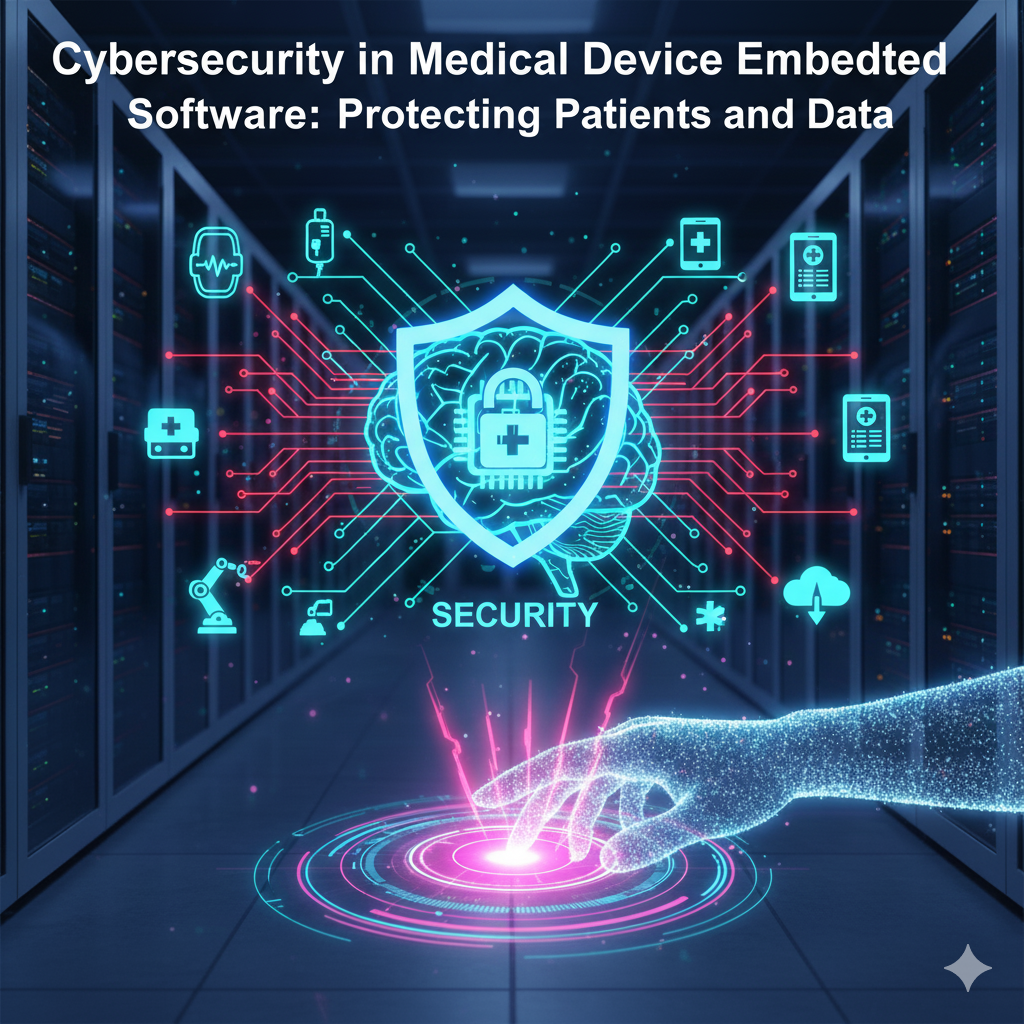Cybersecurity in Medical Device Embedded Software: Protecting Patients and Data

Introduction
In today’s connected healthcare ecosystem, medical devices are no longer isolated systems. From hospital equipment linked to hospital networks to wearable monitors connected to smartphones and cloud platforms, the medical world now depends on embedded software that communicates in real time across multiple environments.
While this connectivity enables smarter, faster, and more personalized care, it also introduces new vulnerabilities. Cyberattacks targeting medical devices have moved from theoretical risks to real-world threats—compromising not only sensitive patient data but potentially patient safety itself.
As a result, cybersecurity in medical device embedded software has become one of the most critical aspects of modern healthcare technology design. Let’s explore how developers can safeguard both patients and data through proactive security engineering, compliance, and continuous monitoring.
Why Cybersecurity Matters in Medical Devices
Medical devices today handle an extraordinary volume of data—personal identifiers, clinical information, and even live physiological readings. A single vulnerability in an embedded system could lead to catastrophic outcomes.
The consequences of a cybersecurity breach can include:
- Patient harm: A compromised pacemaker, infusion pump, or insulin pump could deliver incorrect doses or fail to function at critical moments.
- Data theft: Breaches can expose patient medical histories, financial records, and personal information.
- System disruption: Malware can disable hospital systems, halt operations, or block access to essential data (as seen in ransomware attacks).
- Regulatory and legal penalties: Non-compliance with data protection standards like HIPAA or GDPR can lead to severe fines and reputational damage.
For these reasons, cybersecurity is not optional—it’s a foundational element of safe and effective medical device design.
The Expanding Attack Surface in Embedded Medical Systems
The growing integration of medical devices into larger digital ecosystems has dramatically expanded their attack surface. Devices now connect through Wi-Fi, Bluetooth, cellular networks, and even cloud-based APIs. Each interface introduces potential vulnerabilities.
Common cybersecurity risks in medical embedded systems include:
- Unsecured communication channels leading to data interception.
- Firmware manipulation where attackers alter the device’s code.
- Weak authentication protocols allowing unauthorized access.
- Outdated software that lacks security patches.
- Third-party component vulnerabilities embedded within device firmware.
The challenge is that embedded systems often have limited processing power and memory, making traditional IT security measures difficult to implement. Developers must therefore design lightweight, efficient, and fail-safe protection mechanisms specifically suited for constrained environments.
1. Secure Design Begins at the Hardware Level
Cybersecurity for medical devices starts long before software is written—it begins with the hardware architecture.
Hardware-based protection includes:
- Secure boot mechanisms: Ensures the device only runs verified, trusted firmware.
- Hardware root of trust (RoT): Establishes a cryptographic foundation that authenticates every system component.
- Tamper detection: Alerts the system or renders it inoperable if physical tampering is detected.
By embedding security directly into hardware, developers create a foundation for trusted operation and data integrity—critical for devices that may remain in service for years.
2. Secure Software Development Lifecycle (SSDLC)
A robust Secure Software Development Lifecycle (SSDLC) integrates security practices into every phase of development—from concept to deployment and maintenance.
Key elements of an SSDLC include:
- Threat modeling: Identifying potential vulnerabilities early and defining mitigation strategies.
- Static and dynamic code analysis: Detecting security flaws during coding and testing.
- Code signing and encryption: Protecting firmware integrity and ensuring only verified updates are installed.
- Secure coding standards: Following best practices such as MISRA C or CERT C for reliable, error-free code.
This proactive approach helps eliminate vulnerabilities before devices reach the market, reducing the need for costly post-market fixes.
3. Authentication, Encryption, and Access Control
One of the most effective ways to secure medical embedded systems is by implementing strong authentication and encryption mechanisms.
Authentication:
Every device, user, and system component must be verified before communication begins. This includes multi-factor authentication (MFA) for clinicians, digital certificates for devices, and token-based systems for APIs.
Encryption:
All sensitive data—whether stored locally or transmitted over networks—must be encrypted using protocols like AES-256 or TLS 1.3. Even if attackers gain access, encryption ensures the data remains unreadable.
Access control:
Role-based access ensures that users and systems only have permission to perform actions necessary for their role. Limiting privileges significantly reduces the risk of misuse or data exposure.
4. Regular Updates and Patch Management
Cyber threats evolve daily, and so must device protection. Regular software updates are essential for addressing newly discovered vulnerabilities.
Developers can achieve this through secure over-the-air (OTA) updates, which allow devices to receive verified firmware patches without manual intervention. However, these updates must be:
- Digitally signed: Prevents malicious code from being installed.
- Authenticated: Ensures updates originate from trusted sources.
- Fail-safe: Devices must revert to a stable version if an update fails.
Continuous maintenance not only protects devices in the field but also demonstrates regulatory compliance with frameworks such as the FDA’s Cybersecurity in Medical Devices Guidance (2023).
5. Post-Market Surveillance and Incident Response
Cybersecurity isn’t a one-time activity—it’s an ongoing responsibility. Once devices are deployed, manufacturers must actively monitor them for anomalies, vulnerabilities, and potential attacks.
Effective post-market cybersecurity management includes:
- Real-time monitoring: Detecting irregular patterns in device communication or performance.
- Incident response plans: Defining protocols for containment, investigation, and notification in case of breaches.
- Vulnerability disclosure programs: Encouraging researchers and users to report security issues responsibly.
This continuous vigilance ensures that manufacturers can respond swiftly to threats before they escalate into patient safety risks.
6. Compliance and Standards: Building Trust Through Regulation
Global regulators recognize cybersecurity as a core aspect of patient safety. Compliance with key standards and frameworks helps ensure robust, consistent protection across devices:
- IEC 81001-5-1: Security activities in the software life cycle.
- FDA Guidance (2023): Cybersecurity in Medical Devices: Quality System Considerations.
- ISO/IEC 27001: Information security management systems.
- NIST SP 800-53: Security and privacy controls for information systems.
Adhering to these frameworks not only strengthens device resilience but also enhances trust among hospitals, clinicians, and patients.
7. Balancing Security with Performance and Usability
While cybersecurity is essential, excessive protection can impact device usability or performance. Designers must balance security measures with real-time responsiveness, especially in life-critical systems.
Lightweight cryptographic algorithms, efficient key management, and optimized RTOS integration ensure that security does not compromise speed or reliability. Ultimately, secure design should be invisible to the user but impenetrable to attackers.
Conclusion
The convergence of healthcare and technology has created enormous potential for improving patient outcomes—but it has also opened new doors for cyber threats. As medical devices become increasingly connected, cybersecurity in embedded software must evolve from an afterthought to a core design principle. Protecting patients means more than preventing data breaches—it means ensuring that every device performs safely, reliably, and securely, no matter what threats emerge. By integrating cybersecurity from the hardware level to post-market monitoring, manufacturers can build a healthcare ecosystem where innovation and safety coexist seamlessly.
Read More: Why Life Sciences Software Solutions are the Catalyst for a Healthier Future



